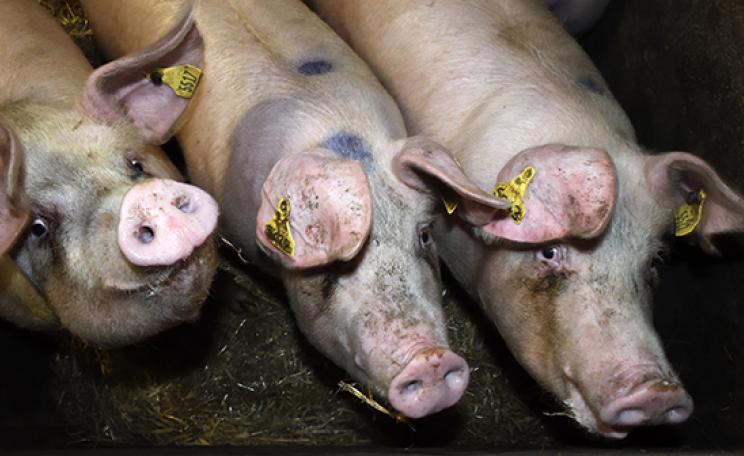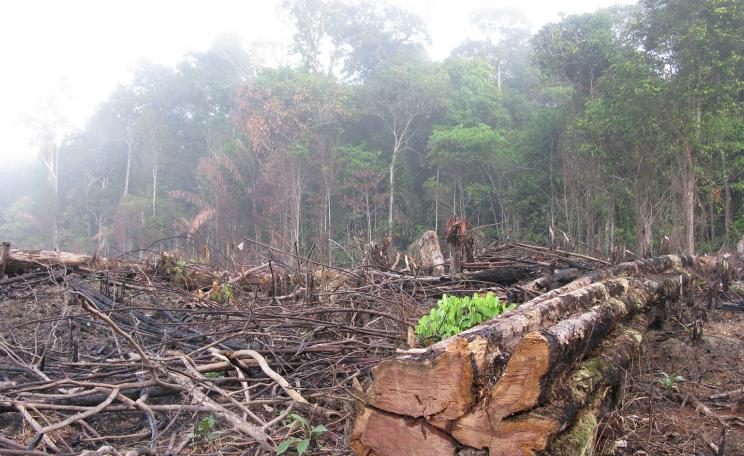The Canadian seal cull, which takes place each spring off the country’s east coast, has become an annual showdown between campaigners and the Canadian authorities. It sees as many as 300,000 harp seals shot or clubbed to death for their fur and other byproducts, including oil, meat and body parts prized for aphrodisiac purposes.
Repeatedly condemned as ‘barbaric’ by animal welfare campaigners, these bloody scenes on the ice floes nevertheless seem disconnected from life in Britain. But new evidence shows that UK-registered companies are at the centre of a global trade in Canadian sealskins.
An investigation by the Ecologist has revealed how a number of London-based fur dealers are procuring the controversial skins from Canadian companies and shipping them to Europe and Scandinavia, before despatching them to China and elsewhere to be manufactured into fur garments and fashion accessories – including coats, scarves, hats and handbags – sold across the world.
Canada’s cull of the wild
Activists claim the seal cull is cruel and unsustainable. They say that many seals are shot but not killed outright – many allegedly retreat underwater where they are unreachable and thus left to suffer a lingering death – or are repeatedly clubbed before being dragged to nearby sealing boats for skinning, in some instances while still alive.
Video footage obtained by the International Fund for Animal Welfare (IFAW) showing the violent, prolonged killing of seal pups during last year’s cull provoked criticism of the hunt and put the issue back on the international agenda. Campaigners and journalists attempting to obtain pictures without a permit.
The Canadian authorities and the fur lobby maintain that the hunt is economically and culturally important, and that the killing is humane and subject to strict guidelines and observation by veterinary experts. The International Fur Trade Federation (IFTF) refers to sealing as an ‘excellent example of a renewable resource industry’ and claims the landed value of seal pelts in 2006 was almost $30 million.
The fur lobby also argues that the hunt is sustainable, with strict annual quotas in place to prevent overexploitation – something hotly contested by animal welfare groups, which point to research suggesting seal populations are under threat from both overhunting and degradation of habitat due to climate change. The quota for this year’s hunt, which got under way last month, has been set at 280,000 by the Canadian government.
Although some seal hunting in Canada is carried out by indigenous groups, most of the killing, say campaigners, is undertaken by fishermen working on a commercial basis.
On the trail
Seal hunting is an emotive issue with the British public, and the Government is under increasing pressure to pursue a ban on seal products. Several European countries – including the Netherlands and Belgium, as well as the US – have already outlawed seal goods, and in May this year the EU as a whole is expected to vote on whether to implement legislation for a complete ban.
Campaigners have long suspected that UKbased dealers are playing a role in fuelling the international trade in sealskins, but little has been known about the companies or trading routes involved – until now.
Posing as fur-buyers, Ecologist reporters tracked the complex trail of skins from Canada to the Far East, via several European countries, including Britain, and met with representatives of UK businesses offering seal pelts on a commercial basis. Although there was no suggestion of illegality or wrongdoing by any of those involved, the disclosure that British businesses are involved in such a trade could prove controversial.
The Ecologist has established that one of the world’s major players in the sealskin trade is London-registered Alaska Brokerage International (AB International). Run by Peter Bartfeld and his son Gideon, the company – along with another enterprise called Bartfeld Trading Limited – has offices in London and New York, and each year buys skins originating from the Canadian hunt before exporting them to China and Russia for manufacture into clothing and accessories.
Undercover reporters met with representatives of AB International on two separate occasions, in London and Beijing, and were told that sealskin forms a ‘large part’ of the company’s business. Gideon Bartfeld offered reporters the pelts of ‘beaters’ – young harp seals, some of which are unable to swim properly – as younger animals are considered by the fur industry to yield the best-quality skins and furs. Top-grade pelts can command $22 each, while lower-quality specimens as little as $8 each, according to AB International.
Bartfeld disclosed that the company is the main European agent for GC Rieber Skinn AA, one of the world’s biggest suppliers of dressed sealskin and fur to garment, footwear and accessory manufacturers. Each year the Norwegian company, a subsidiary of the giant GC Rieber group, which also has interests in shipping, real estate and minerals, purchases between 50 and 80 per cent of the Canadian seal catch – approximately 150,000 and 200,000 pelts – along with skins from similar
hunts in Norway, Namibia and Russia.
In Canada, after the skins are collected from the ice, they are taken to a plant in Newfoundland, where subsidiary GC Rieber Carino Company Ltd initially sorts them before they are dispatched for full processing in Tromsø, Norway.
AB International’s contract with Rieber sees them access skins on a regular basis and in tune with customers’ requirements. ‘Our customers say they want skins in January, April and March [for example], and they give us colours and grades and every month they are shipped out,’ Bartfeld said. ‘Basically 90 per cent [of Rieber’s seal fur] goes to us, to China, and to Russia.’
Bartfeld told Ecologist reporters that AB International itself ships skins from Norway to a dealer in China, who in turn sells on to manufacturers, and to a broker in Helsinki, Finland – KH Furs International – who exports the sealskins into Russia. Both China and Russia are major destinations for sealskins to be turned into winter coats, hats and other garments.
Some AB International skins are imported directly into the UK, however – particularly, according to Bartfeld, lowerquality specimens, typically used in the manufacture of accessories. Southampton is among the UK ports that have been used by AB International.
The company says that its Rieber skins are the highest quality in the world: ‘We’ve been working with [Rieber] for 60 years… Their products are just a different class,’ Bartfeld said. ‘It is not easy to do the dressing, other people just don’t do it as well.’ He said that they occasionally buy from a second company – a Canadian factory called Newmil – but these skins are reserved for customers wanting a ‘cheaper product’.
During a meeting at AB’s North London HQ, Bartfeld disclosed how he visits the Rieber factory twice a year and would have liked to attend a recent seal hunt in Canada in person. He also joked that the company is thinking of diversifying by ‘starting stag weekends going seal clubbing’.
AB International has been caught up in controversy previously. Peter Bartfeld, Gideon’s father, a former director of the British Fur Trade Association, was exposed by the BBC in 1999 after a representative of the company admitted to an investigative reporter from the Newsnight programme that it was willing to supply Chinese cat and dog skins to clients, but using strict code words to disguise the fur’s origin because of British sensitivities to such products.
A spreading network
A second London-based company identified as dealing in sealskins is Infelber Ltd, run by David Morgan and Michael Lepski. During a tour of the company’s London warehouse, Ecologist reporters secretly filmed a variety of sealskins from both Canada and elsewhere, and were told by Bartfeld that the Infelber philosophy is to supply furs or skins from virtually any animal required.
Infelber works closely with AB International, which uses the Infelber warehouse to store furs imported into the UK. As well as sealskins, Infelber is a major player in the procurement and supply of other fur products, including farmed mink. According to Bartfeld the company always has in stock some 200,000 mink furs.
The Ecologist has uncovered a third significant supplier of sealskins operating from the UK – Fein and Co. The company, based out of offices in central London, procures and exports sealskins for the Russian market and sources its Canadian skins from a rival to Rieber: Tamasu, based in Quebec’s Magdalen Islands.
Owned by Jerome Guimont, Tamasu is understood to procure approximately 10,000 sealskins annually, which undergo initial processing in Canada before being shipped overseas to China or to Germany, many destined for the specialist tannery MPV Franke KG, based near Stuttgart. Fein & Co trades Tamasu skins in Russia via its representative Troika, which sells the skins on to hat and other fur garment manufacturers for retailing in Russia and beyond.
Although much of the clothing and accessories manufactured in Russia and China serve those countries’ domestic markets, items containing sealskin have been found on sale across the European Union in recent years, including in the UK. Last year it was revealed by Sky News how sporrans – traditional Scottish fancydress items often used to decorate kilts – were being made using Canadian sealskin. In recent years, leading fashion houses including Prada, Versace and Gucci have been criticised by groups such as the Humane Society of the United States for using Canadian sealskins in the manufacture of their clothing.
Don’t join the club
Seal remains in demand from some manufacturers, though IFAW claims that the global market for seal fur is saturated, causing prices to drop by almost half, with processors reporting that sales of seal pelts all but stopped at the end of 2007 – and have still not recovered. IFAW says this supports the case that this year’s hunt quota is too high and – more importantly – that there is no economic reason for the cull to continue.
Campaigners have expressed concern that UK fur dealers are involved in the trade in sealskins, and are lobbying the EU parliament to vote to introduce a Europe-wide ban on such products in May this year.
Opposition to the import of Canadian sealskin products has been growing for some years, leading to MEPs from across the political spectrum calling for legislation to outlaw the trade. The British Government is opposed to Canada’s commercial seal hunt, but it has stated that it would rather work through the European Union than implement domestic legislation.
Although an EU ban would not prevent the Canadian hunt from taking place, and possible loopholes may enable European fur dealers to continue trading sealskins ‘remotely’, activists say it would seriously disrupt the global trade – no European ports could be used for the transit of seal items – and make the business even less financially viable than it currently is.
Andrew Wasley is a journalist with investigative agency Ecostorm
-----
What's the true cost of the fur industry?
Sealskins, although controversial, represent just one part of a truly global and highly lucrative fur industry.
Worldwide it has been estimated that more than 40 million animals are killed for their fur annually – some 85 per cent are bred and killed on fur farms, the rest are trapped in the wild. This figure does not include the millions of rabbits killed annually, whether bred specifically for their fur or for their meat, with the fur a byproduct. commonly farmed fur-bearing animals include mink, foxes, chinchillas, otters and even hamsters.
Sixty-four percent of fur farms are believed to be in northern europe, 11 per cent are in North America and the rest dispersed throughout the world, in countries such as Argentina and Russia.
In the EU there are some 6,500 fur farms, and Europe is responsible for 70 per cent of globalmink-fur production, and 63 per cent of fox-fur production. The countries that farm the most animals for their fur are Denmark, China and Finland.
Although the majority of the animals that are slaughtered for their fur are killed in these notoriously cruel fur farms, each year trappers kill millions of raccoons, coyotes, wolves, bobcats, opossums, nutria, beavers, otters and other fur-bearing animals.
It is estimated that approximately two million cats and dogs are slaughtered in Asia each year for their fur, many of them in China.
Demand for fur exists worldwide, but the largest consuming markets are china, Italy, Germany, Korea, Japan, Russia and many of the former Soviet Republics, Spain and the US.
In recent years, fur has undergone a renaissance in the fashion world, with in excess of 350 leading international designers working with fur in their collections. In 2004/05, international sales of fur garments reached a value of some $12,770 billion.
Tian Spain
A response from the fur industry…
The Ecologist contacted the British companies involved and was referred to the British Fur Trade Association, which said:
‘There is no conservation reason to ban the trade in seals. The Canadian seal hunt is well regulated and monitored by scientists. Victims of this ban will be the growing seal populations and the communities, including the Inuit, that depend on them. In many countries, including Canada , Greenland , Namibia , Norway , Russia , South Africa and Uruguay, sealing provides essential food supplies and a rare opportunity to earn cash income for aboriginal and coastal communities.
‘The international fur trade is calling for the EU to encourage international welfare standards for all seals, including those hunted for population management reasons within the EU, and to allow derogations to the proposed ban for countries that can meet these standards. ‘In terms of negative impact to the UK trading company, it would of course have some impact, but most importantly it would deny consumers of a traditional, warm, durable and beautiful product while missing a unique opportunity to develop [at EU-level] welfare standards for hunting seals.’
For more information
- Write to your MEP to support the proposed EU legislation. If you don’t know your MEP log on to Write To Them to find out.
- Add your voice to the Humane Society International’s Ban the Cruel Seal Trade campaign
- International Fund for Animal Welfare
This article first appeared in the Ecologist May 2009







